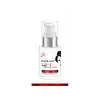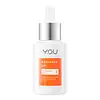What's inside
What's inside
 Key Ingredients
Key Ingredients

 Benefits
Benefits

 Concerns
Concerns

 Ingredients Side-by-side
Ingredients Side-by-side

Water
Skin ConditioningNiacinamide
SmoothingGlycerin
HumectantGlyceryl Acrylate/Acrylic Acid Copolymer
HumectantPropylene Glycol
HumectantPvm/Ma Copolymer
Emulsion StabilisingPentylene Glycol
Skin ConditioningKojic Acid
AntioxidantSaccharide Isomerate
HumectantCitric Acid
BufferingSodium Citrate
BufferingMenthyl Lactate
MaskingPPG-26-Buteth-26
Skin ConditioningPEG-40 Hydrogenated Castor Oil
EmulsifyingSodium Polyacrylate
AbsorbentCaprylyl Glycol
EmollientPhenoxyethanol
PreservativeSodium Ascorbyl Phosphate
AntioxidantTocopheryl Acetate
AntioxidantPanthenol
Skin ConditioningSodium Hyaluronate
HumectantParfum
MaskingBHT
AntioxidantAllantoin
Skin ConditioningDisodium EDTA
Water, Niacinamide, Glycerin, Glyceryl Acrylate/Acrylic Acid Copolymer, Propylene Glycol, Pvm/Ma Copolymer, Pentylene Glycol, Kojic Acid, Saccharide Isomerate, Citric Acid, Sodium Citrate, Menthyl Lactate, PPG-26-Buteth-26, PEG-40 Hydrogenated Castor Oil, Sodium Polyacrylate, Caprylyl Glycol, Phenoxyethanol, Sodium Ascorbyl Phosphate, Tocopheryl Acetate, Panthenol, Sodium Hyaluronate, Parfum, BHT, Allantoin, Disodium EDTA
Water
Skin ConditioningNiacinamide
SmoothingGlycerin
HumectantButylene Glycol
Humectant3-O-Ethyl Ascorbic Acid
Skin ConditioningHydroxyethyl Urea
HumectantHydroxyacetophenone
Antioxidant1,2-Hexanediol
Skin ConditioningPEG-40 Hydrogenated Castor Oil
EmulsifyingZea Mays Starch
AbsorbentAcrylates/C10-30 Alkyl Acrylate Crosspolymer
Emulsion StabilisingTriethanolamine
BufferingHydrolyzed Corn Starch Octenylsuccinate
AbsorbentHydrolyzed Corn Starch
HumectantPolyacrylate Crosspolymer-6
Emulsion StabilisingButyrospermum Parkii Butter Extract
Skin ConditioningPropanediol
SolventCocamidopropyl Dimethylamine
EmulsifyingDisodium EDTA
Isododecane
EmollientXanthan Gum
EmulsifyingPhenylethyl Resorcinol
AntioxidantLactic Acid
BufferingGlycyrrhiza Glabra Root Extract
BleachingPEG-14m
Emulsion StabilisingDecarboxy Carnosine Hcl
Skin ConditioningCocos Nucifera Oil
MaskingIsopropyl Palmitate
EmollientCitrus Limon Fruit Oil
AstringentPelargonium Graveolens Flower Oil
MaskingCitrus Aurantium Bergamia Fruit Oil
MaskingAstragalus Membranaceus Root Extract
EmollientPalmitoyl Tripeptide-5
Skin ConditioningHydrated Silica
AbrasiveCamellia Japonica Flower Extract
EmollientSaposhnikovia Divaricata Root Extract
AntimicrobialCalendula Officinalis Flower Extract
MaskingAlbizia Julibrissin Flower Extract
Skin ConditioningGastrodia Elata Root Extract
Skin ConditioningPhenoxyethanol
PreservativePentylene Glycol
Skin ConditioningCaprylyl Glycol
EmollientGentiana Scabra Root Extract
Skin ConditioningWater, Niacinamide, Glycerin, Butylene Glycol, 3-O-Ethyl Ascorbic Acid, Hydroxyethyl Urea, Hydroxyacetophenone, 1,2-Hexanediol, PEG-40 Hydrogenated Castor Oil, Zea Mays Starch, Acrylates/C10-30 Alkyl Acrylate Crosspolymer, Triethanolamine, Hydrolyzed Corn Starch Octenylsuccinate, Hydrolyzed Corn Starch, Polyacrylate Crosspolymer-6, Butyrospermum Parkii Butter Extract, Propanediol, Cocamidopropyl Dimethylamine, Disodium EDTA, Isododecane, Xanthan Gum, Phenylethyl Resorcinol, Lactic Acid, Glycyrrhiza Glabra Root Extract, PEG-14m, Decarboxy Carnosine Hcl, Cocos Nucifera Oil, Isopropyl Palmitate, Citrus Limon Fruit Oil, Pelargonium Graveolens Flower Oil, Citrus Aurantium Bergamia Fruit Oil, Astragalus Membranaceus Root Extract, Palmitoyl Tripeptide-5, Hydrated Silica, Camellia Japonica Flower Extract, Saposhnikovia Divaricata Root Extract, Calendula Officinalis Flower Extract, Albizia Julibrissin Flower Extract, Gastrodia Elata Root Extract, Phenoxyethanol, Pentylene Glycol, Caprylyl Glycol, Gentiana Scabra Root Extract
Ingredients Explained
These ingredients are found in both products.
Ingredients higher up in an ingredient list are typically present in a larger amount.
Caprylyl Glycol is a humectant and emollient, meaning it attracts and preserves moisture.
It is a common ingredient in many products, especially those designed to hydrate skin. The primary benefits are retaining moisture, skin softening, and promoting a healthy skin barrier.
Though Caprylyl Glycol is an alcohol derived from fatty acids, it is not the kind that can dry out skin.
This ingredient is also used as a preservative to extend the life of products. It has slight antimicrobial properties.
Learn more about Caprylyl GlycolDisodium EDTA plays a role in making products more stable by aiding other preservatives.
It is a chelating agent, meaning it neutralizes metal ions that may be found in a product.
Disodium EDTA is a salt of edetic acid and is found to be safe in cosmetic ingredients.
Learn more about Disodium EDTAGlycerin is already naturally found in your skin. It helps moisturize and protect your skin.
A study from 2016 found glycerin to be more effective as a humectant than AHAs and hyaluronic acid.
As a humectant, it helps the skin stay hydrated by pulling moisture to your skin. The low molecular weight of glycerin allows it to pull moisture into the deeper layers of your skin.
Hydrated skin improves your skin barrier; Your skin barrier helps protect against irritants and bacteria.
Glycerin has also been found to have antimicrobial and antiviral properties. Due to these properties, glycerin is often used in wound and burn treatments.
In cosmetics, glycerin is usually derived from plants such as soybean or palm. However, it can also be sourced from animals, such as tallow or animal fat.
This ingredient is organic, colorless, odorless, and non-toxic.
Glycerin is the name for this ingredient in American English. British English uses Glycerol/Glycerine.
Learn more about GlycerinNiacinamide is a multitasking form of vitamin B3 that strengthens the skin barrier, reduces pores and dark spots, regulates oil, and improves signs of aging.
And the best part? It's gentle and well-tolerated by most skin types, including sensitive and reactive skin.
You might have heard of "niacin flush", or the reddening of skin that causes itchiness. Niacinamide has not been found to cause this.
In very rare cases, some individuals may not be able to tolerate niacinamide at all or experience an allergic reaction to it.
If you are experiencing flaking, irritation, and dryness with this ingredient, be sure to double check all your products as this ingredient can be found in all categories of skincare.
When incorporating niacinamide into your routine, look out for concentration amounts. Typically, 5% niacinamide provides benefits such as fading dark spots. However, if you have sensitive skin, it is better to begin with a smaller concentration.
When you apply niacinamide to your skin, your body converts it into nicotinamide adenine dinucleotide (NAD). NAD is an essential coenzyme that is already found in your cells as "fuel" and powers countless biological processes.
In your skin, NAD helps repair cell damage, produce new healthy cells, support collagen production, strengthen the skin barrier, and fight environmental stressors (like UV and pollution).
Our natural NAD levels start to decline with age, leading to slower skin repair, visible aging, and a weaker skin barrier. By providing your skin niacinamide, you're recharging your skin's NAD levels. This leads to stronger, healthier, and younger looking skin.
Another name for vitamin B3 is nicotinamide. This vitamin is water-soluble and our bodies don't store it. We obtain Vitamin B3 from either food or skincare. Meat, fish, wheat, yeast, and leafy greens contain vitamin B3.
The type of niacinamide used in skincare is synthetically created.
Learn more about NiacinamidePeg-40 Hydrogenated Castor Oil is derived from castor oil and polyethylene glycol (PEG). It is used as a emollient and emulsifier.
As an emulsifier, it helps prevent ingredients from separating. It also helps make the other ingredients more soluble; it is often used to solubilize fragrances. This increases spreadability and elongates shelf life in a product.
Emollients help soothe and soften the skin. They do this by creating a protective film on your skin. This barrier helps trap moisture and keeps your skin hydrated. Emollients may be effective at treating dry or itchy skin.
This ingredient may or may not be vegan, depending on the source.
Peg-40 Hydrogenated Castor Oil may not be fungal-acne safe. We recommend speaking with a professional if you have any questions or concerns.
Learn more about PEG-40 Hydrogenated Castor OilPentylene glycol is typically used within a product to thicken it. It also adds a smooth, soft, and moisturizing feel to the product. It is naturally found in plants such as sugar beets.
The hydrophilic trait of Pentylene Glycol makes it a humectant. As a humectant, Pentylene Glycol helps draw moisture from the air to your skin. This can help keep your skin hydrated.
This property also makes Pentylene Glycol a great texture enhancer. It can also help thicken or stabilize a product.
Pentylene Glycol also acts as a mild preservative and helps to keep a product microbe-free.
Some people may experience mild eye and skin irritation from Pentylene Glycol. We always recommend speaking with a professional about using this ingredient in your routine.
Pentylene Glycol has a low molecular weight and is part of the 1,2-glycol family.
Learn more about Pentylene GlycolPhenoxyethanol is a preservative that has germicide, antimicrobial, and aromatic properties. Studies show that phenoxyethanol can prevent microbial growth. By itself, it has a scent that is similar to that of a rose.
It's often used in formulations along with Caprylyl Glycol to preserve the shelf life of products.
Water. It's the most common cosmetic ingredient of all. You'll usually see it at the top of ingredient lists, meaning that it makes up the largest part of the product.
So why is it so popular? Water most often acts as a solvent - this means that it helps dissolve other ingredients into the formulation.
You'll also recognize water as that liquid we all need to stay alive. If you see this, drink a glass of water. Stay hydrated!
Learn more about Water